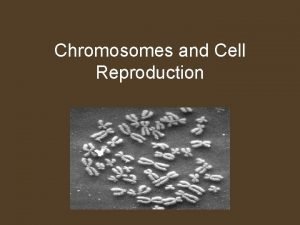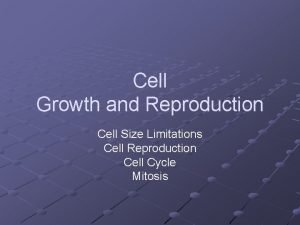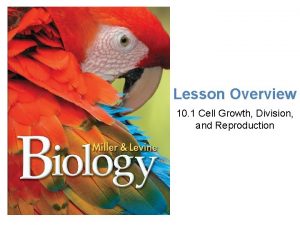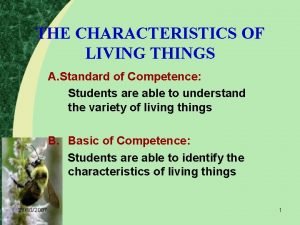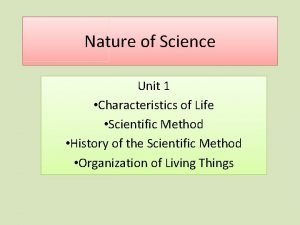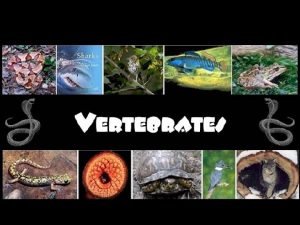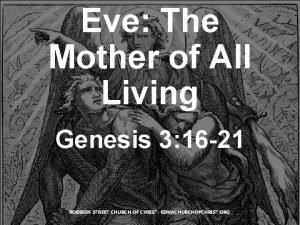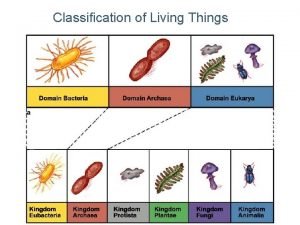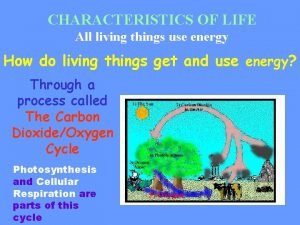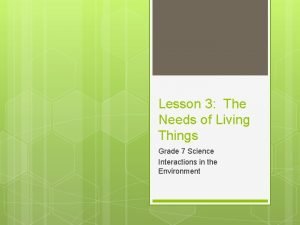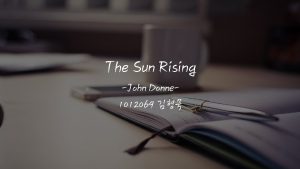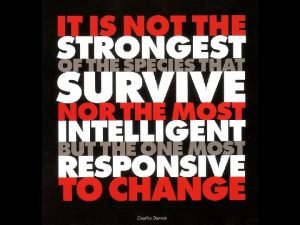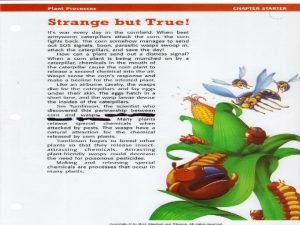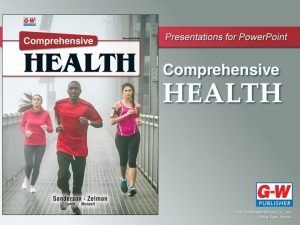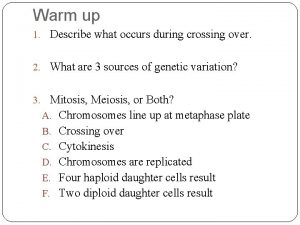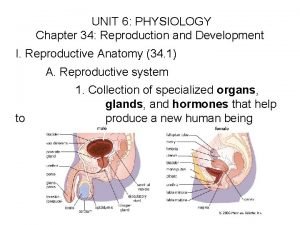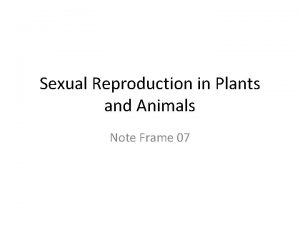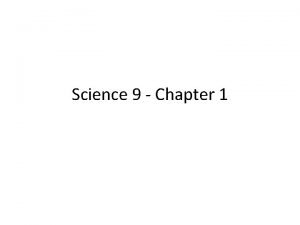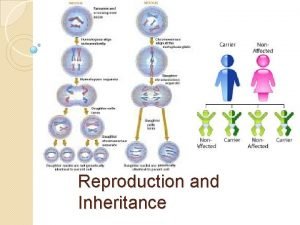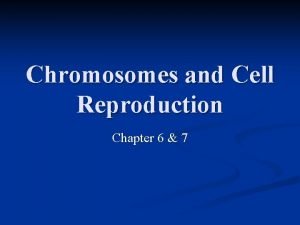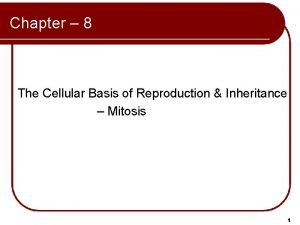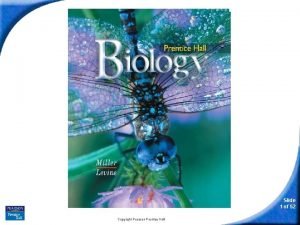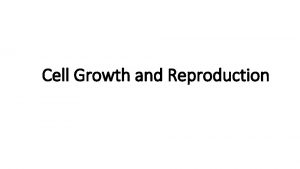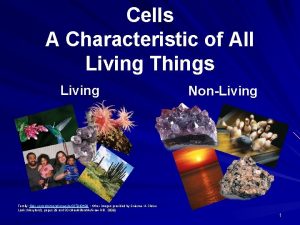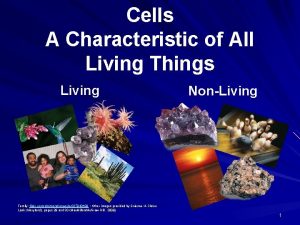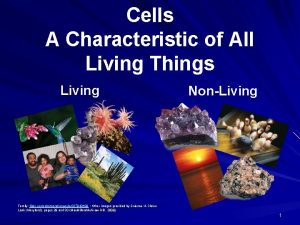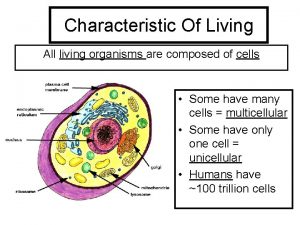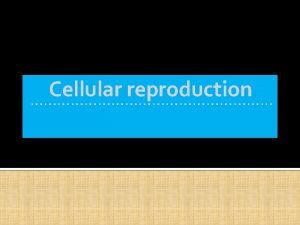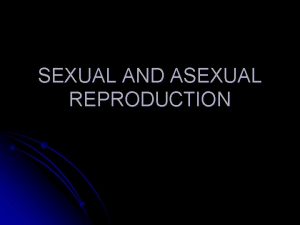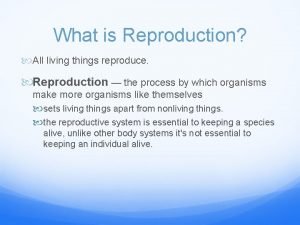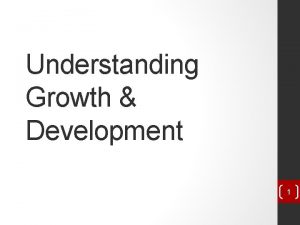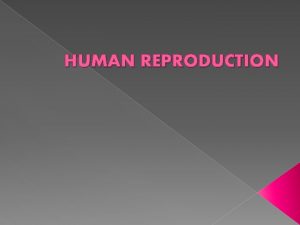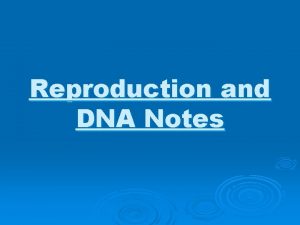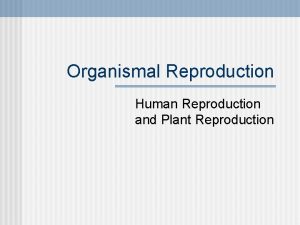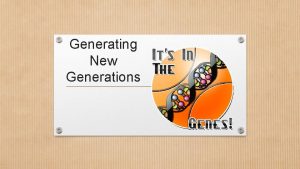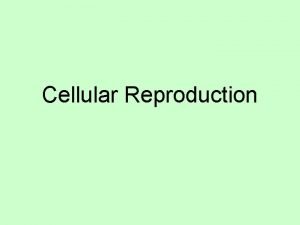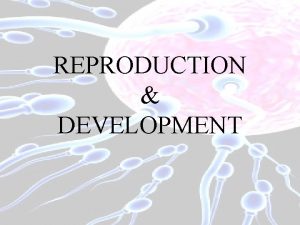Growth and Reproduction l Characteristic of all living






















































- Slides: 54

Growth and Reproduction l Characteristic of all living things – Growth l 2 options Cells can become larger (unicellular and multicellular) – More cells produced (multicellular) – l – Needed for success of the individual Reproduction l 2 options – l Asexual or sexual Needed for the success of the species/population

Growth and Reproduction l Based on portion of cell theory – All cells come from preexisting cells l Genes and chromosomes were inherited from previous generations – l Parents, grandparents, great-grand, etc Continuation of life is dependant on this – Information must be passed from cell to cell, generation to generation l Information is in the form of DNA for all living things l DNA stored in chromosomes

Cell Size l Cells are small – – Surface area to volume limitation 0. 0004 -0. 0008 inches l – – All cells are about the same size Cell size and shape relate to function l – 100 trillion cells in a typical human Remember: Structure determines function Cells of organisms are all about the size l l Muscle cells of a whale is the same size as that of a mouse Whale just has more cells

Limitations on Cell Size l l All base on surface area to volume ratio Limited by 4 main factors – – Availability of nutrients How much cytoplasm the cell can control l – – Supply with nutrients/remove waste Relation of surface area and volume Location of the cell l Different cells have different jobs different size

Differentiation/Specialization l l Found in multicellular organisms Have cells designed to complete specific task Cells take on characteristics to help the organism meet needs All cells have the same genetic info within an organism – DNA in a muscle cell is the same as a nerve cell



Major Terms for Mitosis l Traits: daughter and parent cells have the same traits – – Characteristics passed from parent to offspring Height, eye color, hair color, facial structure, blood type, to many more to list

Major Terms for Mitosis l Heredity: transmission of traits between generations – – Information is carried in the chromosome Asexual l l – All genetic information comes from one parent Offspring are identical to the parent Sexual l l ½ genetic info from each parent Human: 23 chromosomes from mom, 23 from dad

Major Terms for Mitosis l Genes: Segment of DNA which controls hereditary traits – – Points on chromosomes that control certain traits Estimated number of human genes is currently at 20, 000 -25, 000 l Human genome project

Major Terms for Mitosis l Chromatin – How the genetic information is organized when a cell is not dividing l l l Uncoild Genes available to read Nucleic acid wraps around proteins – Proteins called histones

Major Terms for Mitosis l Chromatid – – – Identical copies of the same genetic information Each cell gets one when cell divides Held together by a centromere

Binary Fission l l 1 parent cell divides into 2 daughter cells Binary Fission – – Carried out by bacteria Method of asexual reproduction Bacteria only have 1 chromosome, no nucleus Very simplistic division l l Can happen very rapidly E. Coli will colinize infant gastrointestinal tract within 40 hours (needed for survival)


Mitosis l l Process of cell division when chromosomes in the nucleus of the parent divide into 2 identical sets Cells produce daughter cells that contain same DNA as the parent – l Daughter cells are genetic copies of the parent Involved in asexual reproduction of eukaryotes

Stages of the Cell Cycle l l Interphase (G 1, G 0, S, G 2) Mitosis (M) – – l Prophase Metaphase Anaphase Telophase Cytokinesis(C)

Interphase l l Period between division Genetic info in the form of chromatin Majority of a cells life When normal cell function is carried out

Interphase l G 1: Cell grows – – l G 0: When a cell does not divide – l Nerve, muscle (in adults), kidney, liver S: Synthesis of DNA – – l Right after cell was produced from parent Must get to functional size DNA is copied in preperation for division Each new cell will need its own copy G 2: Growth and preparation for division

Prophase l l l l First stage of mitosis Chromatin shorten and thicken making visible chromosomes Each chromosome consist of 2 chromatids Chromatids held together by centromere Nuclear envelope starts to break down Nucleolus breaks down Centrioles (Centrosome) become visible


arm centromere arm

sister chromatids daughter chromosomes

Prophase

Metaphase l l Chromosomes move to the middle of the spindles between the two poles Line up side by side at the equator Chromatids attach to spindle fibers at the centromere Chromosomes are thick and coiled

Metaphase

Anaphase l l Chromatids separate and are pulled to opposite poles Ends when chromatids reach the sides Once they are split from each other they are considered a chromosome Each pole contains the same number of chromosomes as the parent cell

Anaphase

Telophase l l l Exact opposite of prophase Chromosomes become fine threads (chromatin) Spindle fibers disappear Nuclear membrane reforms Nucleolus begins to reform

Cytokinesis l l Cytoplasm of the cell divides Produces 2 new daughter cells Cell pinches in forming a cleavage furrow Cell plate is formed in organisms with a cell wall

Cytokinesis

Reproduction l Sexual reproduction – – – Union of 2 reproductive cells to form new cells Requires meiosis Reproductive cells called gametes l Male = sperm Female = egg

Reproductive Terms l Gamete – – – Cell with only half the number of chromosomes Sperm/egg Why do they need ½ genetic information?

Reproductive Terms l Fertilization – l Fusion of 2 gametes Zygote – – Result of 2 gametes being fused First cell of a sexually reproduced organism

Reproductive Terms l Diploid – – – l Cell with the complete number of chromosomes Called somatic cells 46 in a human (2 n) Haploid – – Cell that has half the number of chromosomes 23 in human (n)

Reproductive Terms l Meiosis – – Cell reproduction that produces cells with haploid number of chromosomes Broken into Meiosis I and Meiosis II l l Similar to mitosis cell cycle Everything happens twice Except intephase – Do not need to reproduce genetic information between – – – Meiosis I Separates homologous pairs Meiosis II separates chromatids

Asexual Reproduction l l 1 parent Offpring are exact copies of parent – l l Several types based on organism Benefits – l One get copies of one parents chromosomes Quick, large amount of offspring, low energy input, difficulty of finding mate (sessile) Draw backs – Little/no genetic variation

Binary Fission l l Simple form of asexual reproduction Unicellular organism splits into two identical organisms

Budding l l Growth of a reproductive fragment from a parent Contains complete genetic information – Limited cytoplasm

Spore production l l Spores protected by hard shells Can survive harsh conditions

Vegatative Propagation l l l Asexual in plants Make clone of themselves Why do plants need to be able to reproduce a sexually?

Meiosis Cycle l l l Interphase Meiosis I Cytokinesis I Meiosis II Cytokinesis II

Meiotic Interphase l l Very similar to interphase for somatic cells Cell grows, DNA copied, cell prepares for division

Prophase I l l Very similar to Prophase from mitosis Crossing over happens – – Homologous pairs exchange genetic information Group together in a tetrad l – – Tetra = 4 Allows for more diversity in the population What are homologous pairs?

Prophase I

Metaphase I l l Homologous pairs line up on metaphase plate Moved by spindle just like mitosis

Metaphase I

Anaphase I l l Separates the homologous pairs Creates huge possibility for genetic variation – Called independent assortment l l Amount of possible combinations is 2 n For Humans: 223 = 8, 388, 608 possible combinations


Metaphase II l Chromosomes align on the metaphase plate again

l Sister chromatids separated

Overall Meiosis l l Meiosis I : Separates Homologous Pairs Meiosis II: Separates sister chromatids



 Smallest living unit of life
Smallest living unit of life Asexualk
Asexualk Venn diagram of sexual and asexual reproduction
Venn diagram of sexual and asexual reproduction Sexual asexual venn diagram
Sexual asexual venn diagram Growth and reproduction
Growth and reproduction Growth and reproduction
Growth and reproduction Cell growth division and reproduction
Cell growth division and reproduction Whats an energy pyramid
Whats an energy pyramid Phartenogenesis
Phartenogenesis Characteristics of living things
Characteristics of living things Plant growth definition
Plant growth definition Monocot vs eudicot
Monocot vs eudicot Primary growth and secondary growth in plants
Primary growth and secondary growth in plants Chapter 35 plant structure growth and development
Chapter 35 plant structure growth and development Name 3 points
Name 3 points Is it living
Is it living Living non living dead
Living non living dead Step growth polymerization vs chain growth
Step growth polymerization vs chain growth Geometric vs exponential growth
Geometric vs exponential growth Neoclassical growth theory vs. endogenous growth theory
Neoclassical growth theory vs. endogenous growth theory Difference between organic and inorganic growth
Difference between organic and inorganic growth Characteristics of all vertebrates
Characteristics of all vertebrates What are the seven life processes
What are the seven life processes Eve the mother of all living
Eve the mother of all living Why do we classify things
Why do we classify things Tissues group together to form
Tissues group together to form Life cycle of all living things
Life cycle of all living things What are the 5 basic needs of all living things
What are the 5 basic needs of all living things Different types of living organisms
Different types of living organisms Throwaway living
Throwaway living John donne born
John donne born Sexual reproduction and genetics section 1 meiosis
Sexual reproduction and genetics section 1 meiosis What examples of unequal survival/reproductive success
What examples of unequal survival/reproductive success Site:slidetodoc.com
Site:slidetodoc.com Pedigree miscarriage symbol
Pedigree miscarriage symbol Flower structure and reproduction
Flower structure and reproduction Lesson 20.2 the male reproductive system
Lesson 20.2 the male reproductive system Sexual reproduction and genetics section 1 meiosis
Sexual reproduction and genetics section 1 meiosis Sexual and asexual reproduction in animals venn diagram
Sexual and asexual reproduction in animals venn diagram Mitosis vs meiosis
Mitosis vs meiosis Venn diagram of meiosis and mitosis
Venn diagram of meiosis and mitosis Susan bordo the body and the reproduction of femininity
Susan bordo the body and the reproduction of femininity Chapter 10 sexual reproduction and genetics
Chapter 10 sexual reproduction and genetics Asexual reproduction cell division
Asexual reproduction cell division Examples of sexual reproduction
Examples of sexual reproduction What is reproduction and its types
What is reproduction and its types Chapter 34 reproduction and development answer key
Chapter 34 reproduction and development answer key Asexual and sexual reproduction difference
Asexual and sexual reproduction difference Venn diagram of plant and animal reproduction
Venn diagram of plant and animal reproduction Reproduction and inheritance
Reproduction and inheritance Parthenogenesis in mammals
Parthenogenesis in mammals Chapter 6 chromosomes and cell reproduction
Chapter 6 chromosomes and cell reproduction The cellular basis of reproduction and inheritance
The cellular basis of reproduction and inheritance Section 24-1 reproduction with cones and flowers
Section 24-1 reproduction with cones and flowers Love all serve all help ever hurt never meaning in hindi
Love all serve all help ever hurt never meaning in hindi




